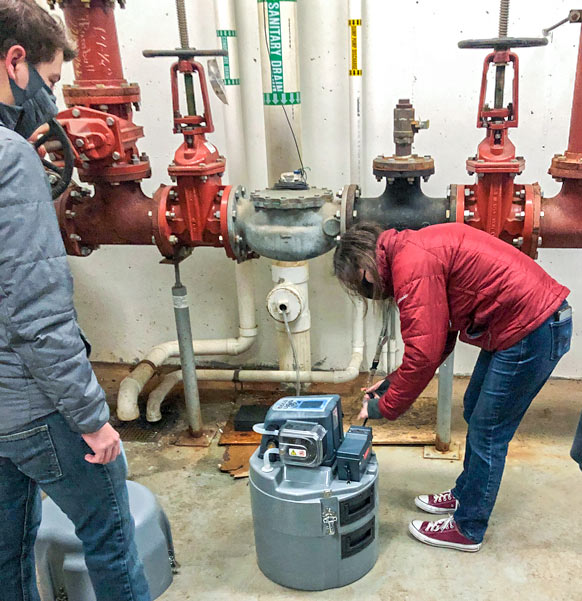COVID-19 research: Wastewater samples may help direct University actions
Research usually takes place in the lab, or sometimes out in a remote location. This time, they called in the plumbers.
It is all a part of a COVID-19 wastewater monitoring project headed up by Dr. John Senko, associate professor of geosciences and biology at UA. Senko is working with University plumbers to obtain the waste samples he needs from five residence halls on campus – Spanton Hall, Bulger Hall, South Hall, Exchange Street Apartments and the Honors Complex.

From left, Clayton Hubler, undergraduate research assistant), and Olivia Hershey, research associate, collect samples in the Exchange Street apartments.
Wastewater samples are collected two days each week in an attempt to measure copies of a gene from the SARS-CoV-2 virus. Senko and his team began the research in January.
Senko is no stranger to wastewater analysis. He has been an integral part of a much larger wastewater project that began back in August 2020 evaluating municipal waste from treatment plants from Akron, Medina, Lorain, Warren and Youngstown.
“Our goal for both projects is to look for fragments of genes of the virus that people have shed in the wastewater and use the abundances of that to see how prevalent it is in that area,” says Senko. “If we see spikes in certain residence halls, for example, we can enhance our preventative action, such as increasing our testing and education.”
Senko’s research with the local municipalities and the University are funded through a series of CARES Act grants designated by the State of Ohio for the pandemic. Similar measures are being carried out in all areas of the state.
Experience for undergraduate researchers
Not only does the wastewater analysis help with the fight against COVID-19, but it also allows UA students to gain research experience. In addition to research associate Olivia Hershey, Senko is aided by graduate research assistant Melissa Mulford, and two undergraduate biology students, Blake Bilinovich of Sharon Township, Ohio, and Clayton Hubler of Ashland, Ohio.
“It is a great opportunity to be part of this wastewater project, but it’s also fun to watch students learning and doing new things in my lab and knowing they can apply these skills to build their future career,” Senko adds.
Bilinovich and Hubler assist with collecting and filtering samples before extracting the genetic materials from them. Both enjoy the hands-on experience a project like this affords them, even though Bilinovich admits it is sometimes a “crappy job.” Pun intended.
Hubler plans to continue to work in research and pursue an advanced degree after graduation. He knows that lab experience is what he needs to set himself apart. “You learn so much in class but doing research in the lab makes it real and helps to strengthen your resume,” he says. “UA also offers a lot of other opportunities such as the tiered mentoring program, internships, clubs and scholarships.”
Bilinovich plans to enter medical school after graduation and says that the analysis and problem-solving skills he is building will be a benefit in addition to the skills he is learning about communication in a professional setting. “It is also exciting to be part of a public health project that is really historic,” he says.
The campus and municipality projects are funded through June. While not long-term projects, Senko and his students feel the experience, and hopefully the impact, is worth it.
“It makes you feel good that you might be contributing something to limit the severity of this pandemic,” he says.
Media contact: Cristine Boyd, 330-972-6476 or cboyd@uakron.edu
